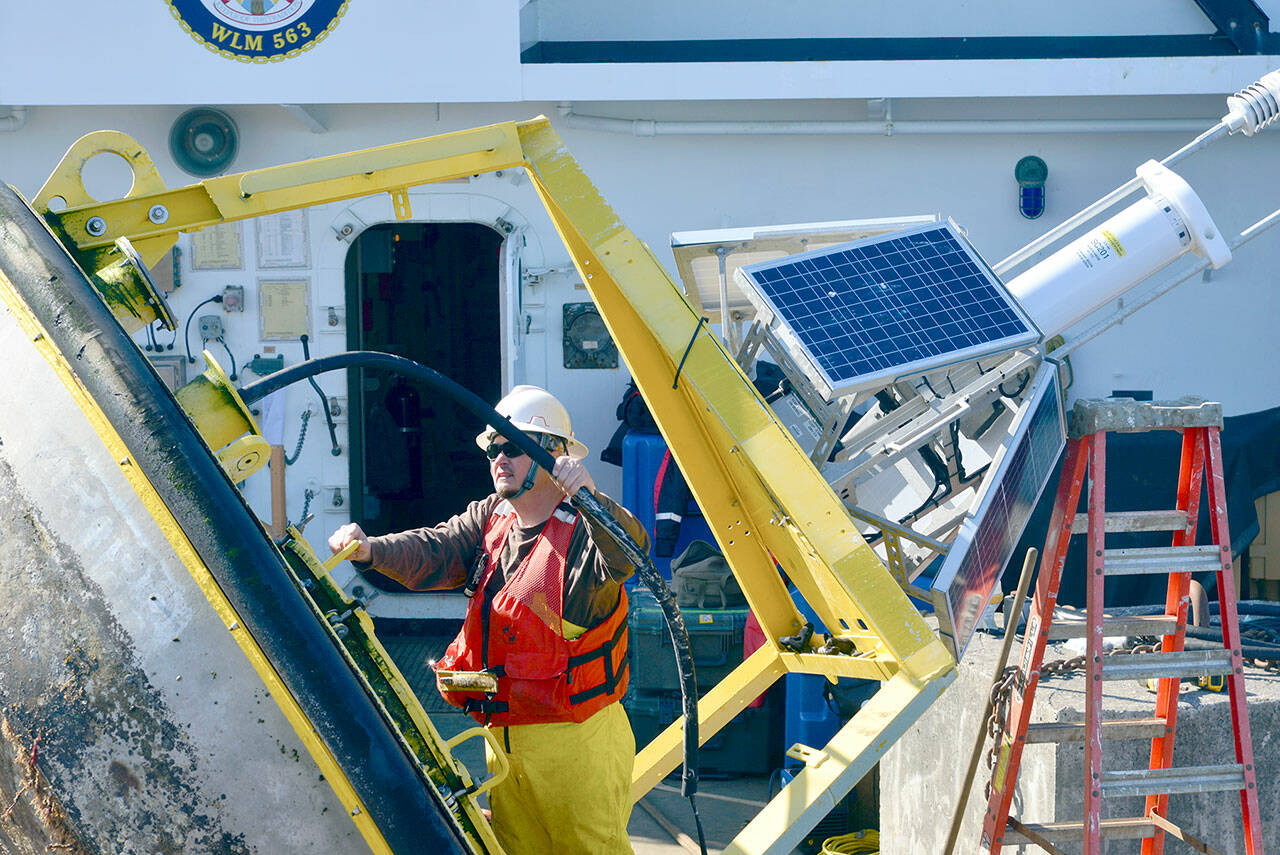PORT ANGELES — The U.S. Coast Guard Cutter Henry Blake pulled out of Port Angeles Harbor with a mission to refurbish a National Oceanic and Atmospheric weather buoy in the Strait of Juan de Fuca that had stopped transmitting data.
The Henry Blake is a Keeper Class coastal buoy tender based out of Naval Station Everett, but it was in Port Angeles on Sept. 20 to service weather buoys in the area with the help of some technicians sent from NOAA’s National Data Buoy Center.
“We try to touch them once a year to ensure they have the proper calibrations,” said USCG Chief Warrant Officer Anthony Cassisa.
This particular buoy, No. 46088, stopped transmitting data in November last year, Cassisa said, and the Coast Guard pays for NOAA to maintain the buoy at its location roughly 20 nautical miles northeast of Port Angeles.
Cassisa and two technicians were dispatched, along with quite a bit of equipment, from the NDBC facility housed at NASA’s John Stennis Space Center in Hancock County, Miss.
“It’s important for mariners for safety, so they can see what the weather conditions are,” Cassisa said. “It allows mariners to get an on-scene visual of that area.”
It took the ship more than an hour to reach the buoy, which is near the U.S.-Canada maritime border, and the crew of the Henry Blake handled the actual loading and unloading of the buoy from the vessel, using the ship’s crane to hoist the 3-meter buoy on and off deck.
Cassisa said the Henry Blake is equipped with a dynamic positioning system; navigation software that gives real-time feedback to a computer aboard the ship which will calculate current and distance for the buoy, and using its 360-degree thrusters, hold the ship in place at a specific location.
The buoy itself is circular and painted yellow with a stand on top where the weather-monitoring equipment is attached. The equipment — which includes a camera, weather vane and other monitoring equipment — comes as a pre-assembled package that crews can swap out with relative ease.
The team headed out with two replacement observation packages, both of them calibrated and tested before Henry Blake left port. Only one will be affixed to buoy 46088, but the team brought a second one just in case.
With the buoy on board, the team and crew immediately set to scraping the barnacles and seaweed growing on the underside of the buoy. Once cleared of marine life, the technicians started removing the old pieces of equipment and replacing them with newer equipment.
The replacement parts aren’t necessarily new, but often refurbished and repurposed from other monitoring stations, Cassisa said.
It takes several hours to remove the old parts and affix the replacements to the buoy. The equipment was all bolted down with heavy-duty bolts, some of which required mechanical drills to unscrew. Once back in the water, it takes several more to ensure the equipment is working properly.
Standing on the deck with a handheld weather monitoring device connected to a smartphone app, technician James Coleman compared what his own device was reading and compared it to the newly released buoy. Coleman is a contractor with Amentum, an engineering firm based in Falls Church, Va., which works with NOAA to manage its system of weather buoys.
“It’s every 10 minutes for water temp, wind speed and direction,” Coleman said of the buoy’s data transmissions. “Every 30 minutes for wave height.”
The buoy’s equipment reads information for air and water temperature; wind speed and direction; wave height, frequency and direction; atmospheric pressure and dew point. A camera housed near the top of the monitoring equipment takes panoramic photos every hour during daylight.
Coleman sent his information back to Amentum, which compared the data being sent by buoy 46088 to other weather readings in the area.
After several hours of data transfers, technicians deemed the buoy in working order and the Henry Blake headed back to Port Angeles.
The ship spent another night in Port Angeles before heading out to service another buoy the next day.
The Coast Guard pays for this buoy 46088 to be in place, but it’s part of a system of 1,300 weather monitoring stations in the Pacific and Atlantic Oceans that NOAA manages.
Buoy 46088 is one of more than 200 moored buoys that require annual maintenance, according to NOAA. This year, crews began servicing weather buoys along the West Coast in May, starting in San Diego, Calif., but NOAA also manages a system of tsunami warning buoys around the equator in the Pacific Ocean.
The annual maintenance cost for buoy 46088, including Tuesday’s mission, is roughly $40,000, according to Maureen O’Leary, deputy director of public affairs for the National Weather Service, which is part of NOAA.
Buoy 46088 is one of the smaller buoys deployed by NOAA; some of the larger buoys range from 10-12 meters, but a new buoy would cost roughly $300,000, O’Leary said.
The data is available to the public, and it’s used by various industries, the Coast Guard and commercial weather services like the kind accessed on a smartphone.
Data from buoy 46088 can be found at the National Data Buoy Center’s website, ndbc.noaa.gov.
________
Reporter Peter Segall can be reached a psegall@soundpublishing.com.

